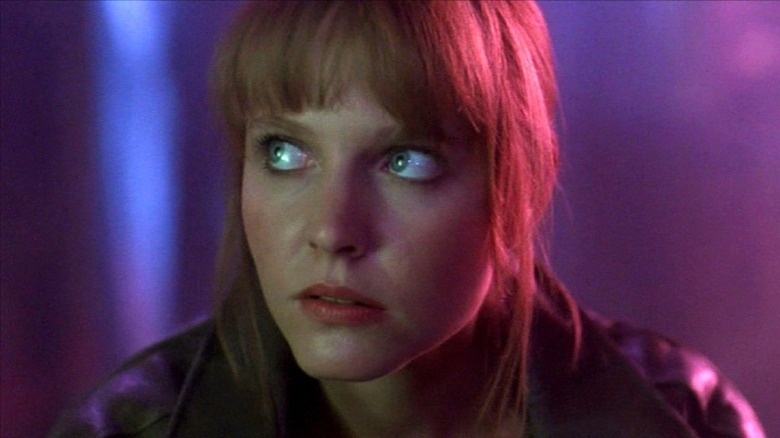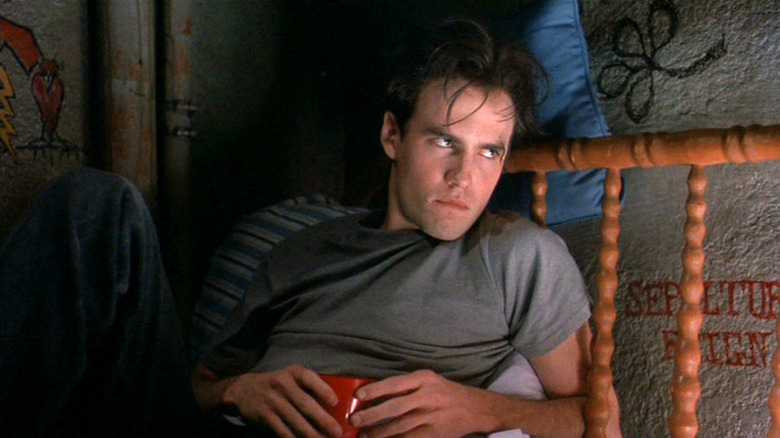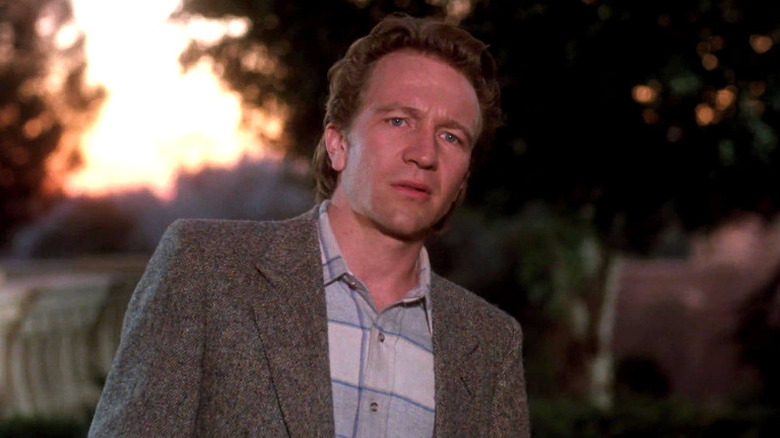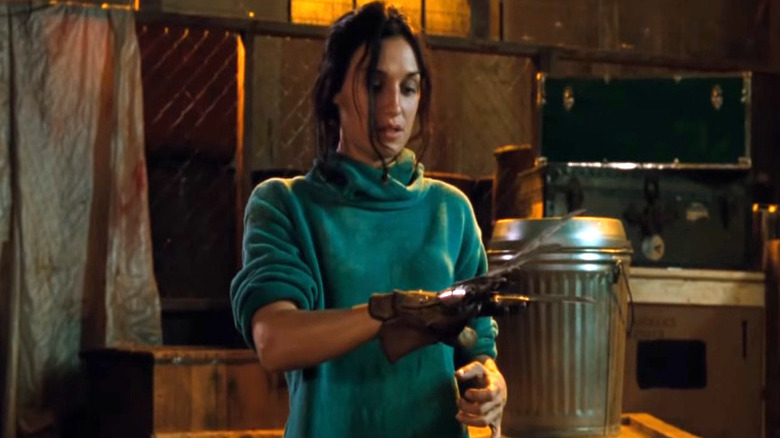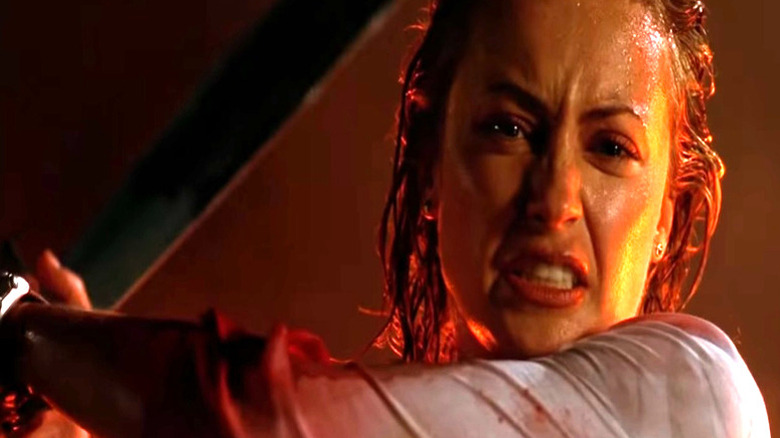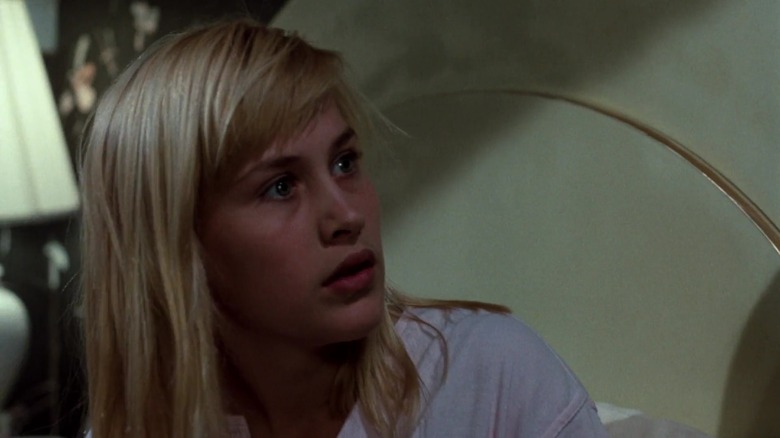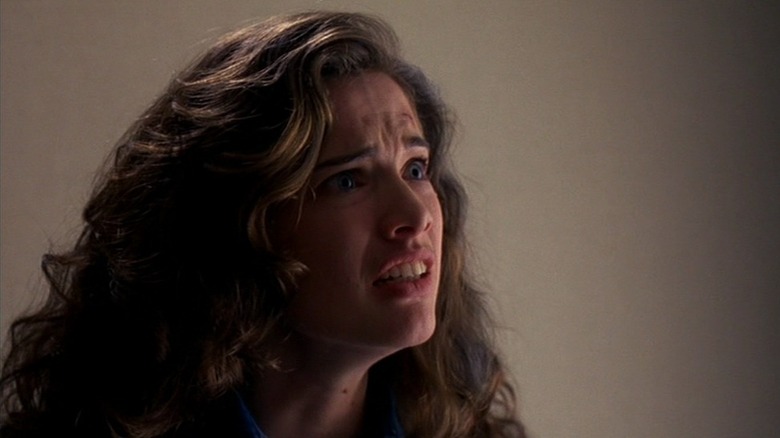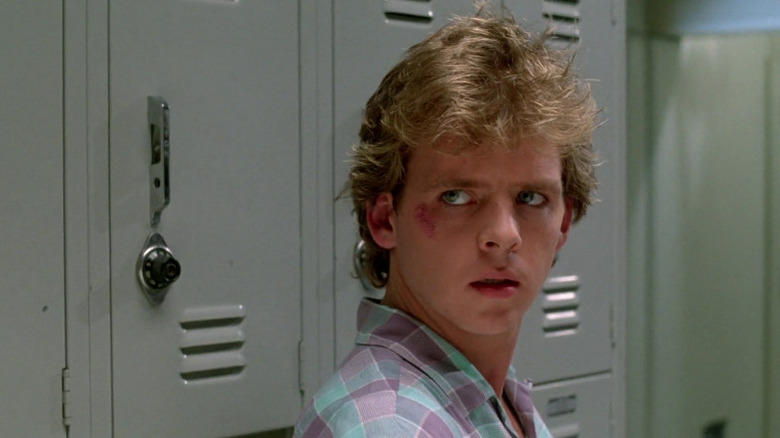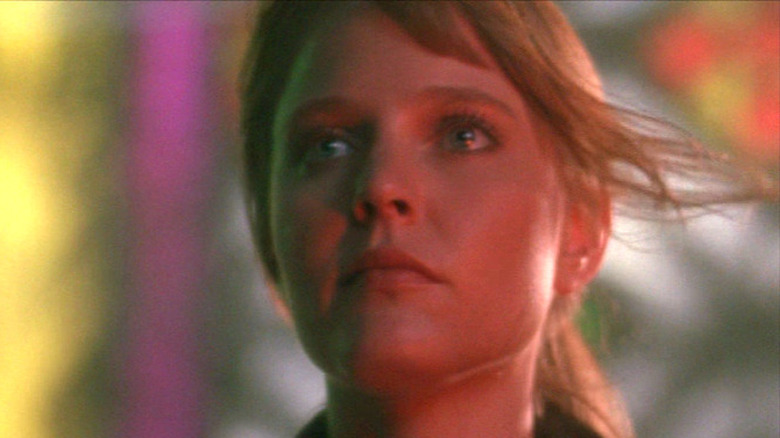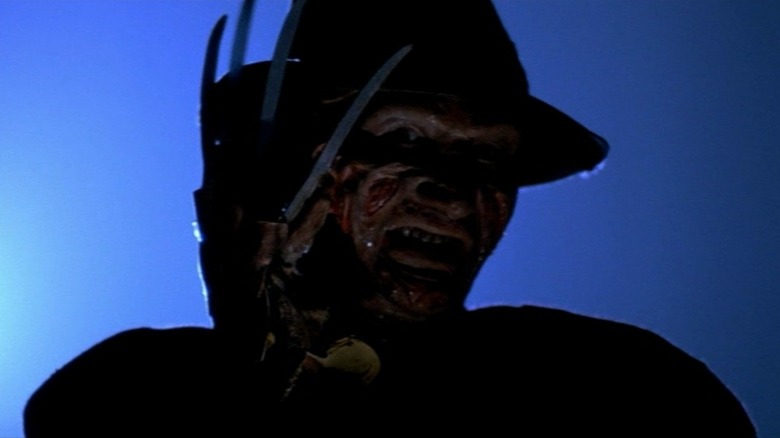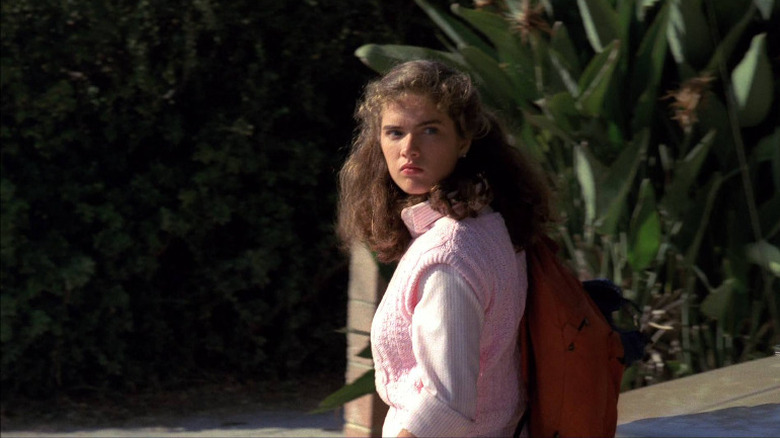Every Main Character From The Nightmare On Elm Street Franchise Ranked
When it comes to the big three slasher franchises of the 1980s, "A Nightmare on Elm Street" is the most creative and daring. While Jason spent his time hacking people apart in the woods without a second thought and Michael hunted down his entire family, Freddy Krueger got to know his victims. He lurked around their subconscious, studying what made them tick in order to concoct his evil nightmares. His effort was demonstrated with imaginative and thrilling dream sequences that really pushed the boundary for what can be accomplished by an independent studio production.
The movies were more than just fantastic set pieces though. There's something deeper going on in the world of "Elm Street." Concepts of generational trauma, children paying for the sins of their parents, and the secrets we keep that result in direct harm to the people we love — these ideas permeate even the silliest entry. The "Nightmare" movies explore the sources of fear while other slashers are simply content to trigger a sudden, superficial jolt of terror. This means that the "Nightmare" characters can't be one-dimensional machete fodder. They require inner lives that come across on screen for us to become invested in.
Over the course of eight films (and a remake that won't get much mention here), "A Nightmare on Elm Street" has given us several characters struggling to battle the metaphorical demons of their past alongside the literal one stalking their dreams. Today, we're ranking each main character and discussing what makes them so great.
10. John Doe
When the character of Freddy Krueger became such an overwhelming pillar of pop culture in the late 1980s (he had a TV series, a vinyl record, and his own 1-900 number), that popularity was too difficult to maintain. Thus, "A Nightmare on Elm Street 5: The Dream Child" underperformed at the box office. So it was decided to kill off the character that built New Line Cinema, and the result was "Freddy's Dead: The Final Nightmare."
Directed by longtime "Nightmare" collaborator Rachel Talalay, the film is a real mixed bag. On the one hand, it has a John Waters meets David Lynch surrealist humor to it, which is pretty entertaining, and Robert Englund is giving everything he's got to play this burned version of Bugs Bunny. On the other hand, the scares are non-existent, and the characters aren't very interesting.
Chief among them is John Doe (Shon Greenblatt). The movie begins with John trying to escape Krueger, only to keep running into him. This is par for the course in a "Nightmare" film, but what makes this different is John isn't sure who this guy is. We follow him to a crisis center where he meets the other characters and comes to believe he's the son of one Fred Krueger. He's wrong. As it turns out, Freddy used John to get to his actual child: his daughter Katherine. It's a neat twist, but it means John ceases to be a character and becomes a function of the plot.
9. Dr. Neil Gordon
It wouldn't be unfair to say that the "Elm Street" sequel most people think of when someone mentions the series is "A Nightmare on Elm Street 3: Dream Warriors." It's the film that nudged everything in a new direction, allowing future storytellers to have fun with the mythology and push themselves creatively. Interestingly, the over-the-top Freddy performance often associated with the sequels doesn't cement itself until part four. In "Dream Warriors," Freddy's still fairly menacing.
The film is a big deal because it brings back characters like final girl Nancy Thompson and her father, establishes that Freddy is the son of a hundred maniacs, and introduces lucid dreaming. At the center of all this is one of the few mature, responsible adult protagonists in the series, a doctor at Westin Hills Psychiatric Hospital named Neil Gordon (Craig Wasson). Unlike most parental figures in these movies, Neil cares deeply about helping the kids tormented by Krueger. The only problem is, he doesn't believe Freddy exists.
Nancy Thompson helps set him straight, and he even winds up battling Freddy's reanimated skeleton by the end. He's willing to do anything to keep these kids safe, which is incredibly admirable. But other than being a warm, caring man, he isn't very interesting. We know almost nothing about his past, why he became a doctor, what his experience is, nothing other than what is already obvious. Had they added just a bit more texture to his character, he would've ranked much higher.
8. Maggie Burroughs
"Freddy's Dead" wants us to believe the amnesiac John Doe is Freddy Krueger's son. In act two, however, it's revealed that Freddy never had a son — he had a daughter. So, John Doe falls onto a massive bed of nails, ventilating his abdomen, and he's gone from the movie. Focus then shifts to a character named Maggie (Lisa Zane). She works at a shelter for troubled teenagers and has been having dreams of her own that she doesn't understand.
In these dreams, she's a little girl playing in the backyard with her father. We then see that her father looks a lot like Robert Englund. When her mother discovers all of his murder stuff in the basement, it becomes clear that Maggie is actually Katherine — Freddy Krueger's daughter. The twist is fun, if predictable, but it's a shame we didn't follow Maggie from the beginning so we could get to know her more.
Other than being Freddy's daughter, we know that (like Dr. Gordon from "Dream Warriors") she seems to really care about the people she's helping, but the workload might be a bit much for her. The familial connection to our main antagonist could've been interesting, but we don't know enough about how her childhood affected her to invest in her journey. If there'd been an additional scene devoted to how the trauma still haunts her (other than just dreams and working in a shelter), then the final confrontation might've been more rewarding.
7. Lori Campbell
Fans had been waiting to see Freddy and Jason face off on the big screen for almost two decades before it finally happened in 2003. Like the classic Universal Monsters before them, "Freddy vs. Jason" should have been the start of a string of films mashing our favorite horror baddies together, but it just didn't happen. Well, at least it happened once, and that's something.
The narrative difficulty in bringing these titans together is that one of them doesn't speak. The filmmakers worked around this well enough, but they couldn't rely on scene after scene of Freddy manipulating Jason's already fractured psychosis. Therefore, regular human teenagers (the favorite style of victims for both killers) were brought in to hold all this fan service together. While most of them are just as vapid and shallow as the majority of "Friday the 13th" characters, Lori Campbell (Monica Keena) actually has a personality and an interesting past.
Freddy murdered her mother, and Lori's boyfriend was blamed for it and sent away. For years, Lori was gaslighted by her father (and the town at large) to suppress the possibility of Krueger returning, but it doesn't work. That kind of connection with Freddy and the journey she takes to gain control of her life is compelling, but she ultimately exists to get Freddy and Jason together in the real world, making her (in the end) a pawn of the plot with the veneer of depth.
6. Kristen Parker
One of the three protagonists in "Dream Warriors" is Kristen Parker. We meet her at the very beginning, constructing Nancy's house out of popsicle sticks and papier-mâché. Her mother is a conceited woman who doesn't believe her daughter's problems are real. In her mind, Kristen is just seeking attention. Even when Freddy slits Kristen's wrists, making it appear as though she tried to commit suicide, her vile mother thinks it's all a psychological mind game.
In "Dream Warriors," Kristen is a very passive character. She's been struggling for a long time, and it's wearing her down. Only through the help of Nancy and the other kids at Westin Hills can she learn to control her ability to pull others into her dreams and finally fight back against her stalker.
Originally played by Patricia Arquette, Tuesday Knight was brought into play her in "A Nightmare on Elm Street 4: The Dream Master." The second Kristen is far more proactive. She refuses to let her friends, Joey and Kincaid, forget that Freddy could still be after them. Even when she's dying in her dream, she very wisely passes her abilities to new friend Alice so she can pick up the fight. Kristen is a relatable and likable character we all want to root for, but her reactive nature in "Dream Warriors" and short-lived heroism in "Dream Master" really hold her back from making it to the top three.
If you or anyone you know is having suicidal thoughts, please call the National Suicide Prevention Lifeline by dialing 988 or by calling 1-800-273-TALK (8255).
5. Heather Langenkamp
Wes Craven, the man who created Freddy Krueger, mostly stayed away from the sequels. He has a credit on "Dream Warriors" thanks to a draft he co-wrote with Bruce Wagner, but he had no real involvement with any of the other movies.
But once Freddy died, New Line went back to the master to see if he had any ideas. Boy did he. "Wes Craven's New Nightmare" is a meta masterpiece that dissects not only the audience's love for the "Nightmare" films but the necessity of horror stories in general. It steps out of the continuity of the films to tell a story about the people who made them, primarily the actress who played Nancy: Heather Langenkamp.
Heather is a wife and mother living in Los Angeles, still orbiting around the franchise that made her famous. Her husband is working on the next installment, and she's doing talk show appearances with Robert Englund. At the same time, she has a stalker (as did the real Heather Langenkamp), and both she and her son are experiencing nightmares involving the fictional slasher from the movies.
Heather is complicated. She has a troublesome past with her mother, she's not thrilled with the direction her life went, but she doesn't curse it either. She's just trying to make the best out of her situation, which makes her very relatable. Langenkamp's performance is great, and we really get a sense that this woman is wrestling with some serious issues, making her journey deeply cathartic.
4. Jesse Walsh
"A Nightmare on Elm Street Part 2: Freddy's Revenge" is divisive. The only returning character is the titular Freddy, and the movie departs from the rules in the third act. Historically, the most divisive aspect of the film has been the main character Jesse Walsh (Mark Patton). He didn't fit a 1985 audience's expectations of what a male protagonist was. His shy, meek demeanor was closer to what they'd come to expect from a scream queen.
In the "Never Sleep Again" documentary, writer David Chaskin says he wanted to write about a kid grappling with his sexuality. Everything about the movie telegraphs to the audience that this is about living your life in the closet. It's very possible that Freddy is an analogy for the kind of personal hell one can experience when they're not allowed to live as themselves.
When viewed through this lens, Jesse's journey is truly terrifying, and he is a fascinating character. His guilt and shame for the way he feels literally splits him in half at one point. Only when his female love interest proves that her love is real is he able to find his way back. Of course, there's nothing to suggest this is romantic love. It could just be a girl accepting a friend for who he is. Unfortunately, the negativity surrounding the film's subtext was so intense, it hurt Patton's career, but he made a wonderful documentary about it called "Scream, Queen! My Nightmare on Elm Street."
3. Alice Johnson
Most of the characters in "A Nightmare on Elm Street" don't like to sleep — with good reason, obviously. Therefore, the fact that Alice (Lisa Wilcox) actually looks forward to dreaming makes her stand out immediately.
We meet her in "A Nightmare on Elm Street 4: The Dream Master" as the sister of Kristen's new boyfriend, Rick. She's quiet and shy (as are many horror movie protagonists) and likes to daydream. For her, dreams are an escape. Her father is an abusive mess. She goes through high school feeling invisible. The only time when she's in control is when she's dreaming. Therefore, it only makes sense that Kristen would choose to pass her powers onto Alice. While the rest of her friends are picked off by Freddy, Alice prepares herself to do battle. Just like Nancy and Kristen before her, she refuses to participate in fear. Instead, she adapts the traits of her fallen friends and finds the dream demon herself.
Alice is the closest this series gets to an action hero in the vein of Ripley from "Aliens" or Sarah Connor in "Terminator 2." She returns for "A Nightmare on Elm Street 5: The Dream Child" and actually makes it through to the end. She's able to do this because she's smart, resourceful, and no longer afraid of herself or anyone else. She's a truly inspiring character. She teaches us that dreams are all well and good, but taking control of your life is what matters.
2. Freddy Krueger
You can't have "A Nightmare on Elm Street" without Freddy Krueger. He is the dirty, evil thing stalking the quiet neighborhoods of America that no one wants to talk about. He is repressed fear, anger, and lust. He is the embodiment of everything we're too frightened to look at and understand. He knows that and uses it to his advantage.
His origin varies slightly the more it's told (especially in the remake), but the original sin of his creation remains the same: Springwood's parents became so disgusted with this man and the faulty justice system that let him go that they burned Krueger alive. While their act of vigilantism let them sleep sounder, all it did was give their children nightmares. A little thing like death can't keep a maniac (or son of a hundred maniacs) down. He came back for their children by entering their dreams.
The subtext of a man capable of violating a space so private we don't even understand it ourselves is every bit as powerful as the visceral shock of seeing someone get sliced by knives. Freddy isn't only an iconic image or performance (courtesy of Robert Englund), he's a rich character and a metaphor. Yes, it's entertaining to watch him have a ball doing the thing he does best, but the reason he endures is because on a deep, subliminal level, he represents society's greatest fear — a secret that won't stay buried.
1. Nancy Thompson
"Freddy's Dead" wasn't the first time "A Nightmare on Elm Street" pulled a bait and switch. The very first film killed off its assumed protagonist, Tina, in the first act. Luckily, she had a friend like Nancy Thompson (Heather Langenkamp) to guide the series following her horrific demise. It's easy to say the original is the best. In the case of the "Elm Street" movies, it's debatable which installment is the best, but what the vast majority of fans will likely agree on is that Nancy is the best protagonist in the entire franchise.
Even if she hadn't returned in "Dream Warriors," she'd still be the best because she personified everything an "Elm Street" hero should be (except the one in the remake). She isn't a pushover, she doesn't back down, and she thinks ahead. We wouldn't have Alice without her. If anything, the leads in these movies probably would have been just another group of ineffectual nobodies for the killer to slaughter if Nancy hadn't set the mold.
Her presence is everywhere during these movies. The journal Jesse finds in his bedroom was hers. He's living in her house. Freddy is so affected by her getting away that he adopts her home as his own, surrounding himself with his failure. She's so powerful and brave that she doesn't even need to physically harm Freddy. Instead, she turns her back on him and refuses to let him control her. That is a great character.
